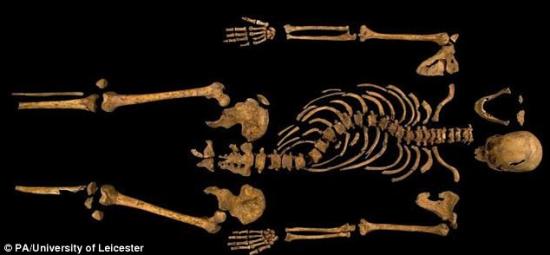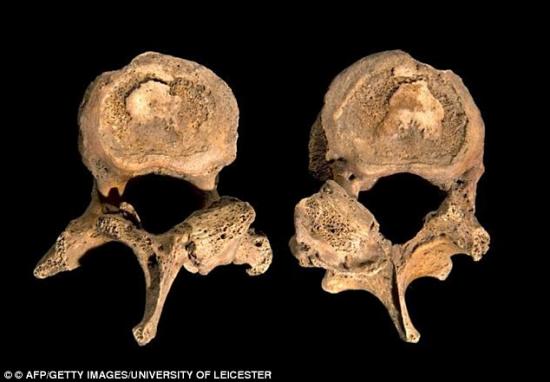Experts cast doubt over accuracy of DNA and dating results
Victoria Woollaston
Source - http://www.dailymail.co.uk/sciencetech/article-2590638/Skeleton-car-park-NOT-Richard-III-Experts-cast-doubts-accuracy-DNA-dating-results.html#ixzz2xBFQAcR9
It's been more than a year since experts announced the remains found in a car park in Leicester were those of King Richard III - but now experts have raised serious concerns about the findings.
Michael Hicks, from Winchester University, and archaeologist Martin Biddle, from the Winchester Research Unit, are challenging the results of the DNA testing, and the accuracy of the radiocarbon dating.
They are even calling for a coroner's court to be set up to independently review all of the evidence.

The University of Leicester concluded the remains belonged to the king during a press conference in February last year, after the body was excavated in September 2012.
They claimed DNA samples matched that of a descendant of the king's maternal line, while the skeleton's spinal curvature also matched accounts of the humpback royal.
The team used radiocarbon dating to determine when the skeleton died, and said this confirmed it was around the same time the king was killed during the Battle of Boswroth in 1485.
Speaking to BBC History Magazine, Professor Hicks argued the remains could belong to a victim of any of the battles fought during the Wars of the Roses: 'Lots of other people who suffered similar wounds could have been buried in the choir of the church where the bones were found,' he explained.
He also queried the project's use of radiocarbon dating, which dates the bones to the period of Richard’s death: 'Such a technique is imprecise. It will give you an era, but nothing more.
'In this case, it covers a period of 80 years.'
Professor Hicks went on to question the prominence given to DNA testing in claims about the identity of the remains, too, adding: 'The DNA match could equally be the result of the bones being those of someone descended in the female line from Richard’s mother, Cecily Neville.'
King Richard’s grandmother, Joan Beaufort, for example, had 16 children, 'which made her the ancestor of much of the nobility of the Wars of the Roses - quite a few of whom died violently in those conflicts,' continued Professor Hicks.
'Indeed, it is very hard to prove that the skeleton belongs to a specific person. The Leicester team themselves acknowledge that it’s extremely rare for archaeologists to find a known individual, let alone a king.'
Professor Biddle echoed these concerns: 'We know very little about the graves in the east end of the church.
'How many burials were made there in the three centuries of the friary’s existence, and indeed after the battle of Bosworth?
'Without further excavation there is no certainty. Before all this goes any further, it would be wise to be certain the body really is his.
'Something akin to a coroner’s court should be set up to consider all the evidence.'

Two vertebrae of the skeleton, believed to belong to King Richard III, were found to show abnormal features relating to scoliosis, or curvature of the spine. Leicester University claimed this find corroborates historical accounts of Richard that described him as a hunchback
n response to the claims Philippa Langley, who commissioned and paid for the excavation, said: 'To say it cannot be claimed ‘with any confidence’ that this is Richard is quite puzzling.
'Given the totality of the evidence, it can surely be said with considerable confidence. Hicks says that there may have been ‘lots of people with similar wounds’: perhaps he could name one who fits the bill?'
Meanwhile, a spokesperson from the University of Leicester added: 'The strength of the identification is that different kinds of evidence all point to the same result. Hicks is entitled to his views, but we would challenge and counter them.
Professor Hicks concluded: 'I’m not saying that it’s not Richard - it’s perfectly conceivable that it is - but we are not in a position to say with any confidence that it’s him.
'Similarly, while the curved spine suggests the skeleton is Richard’s, the presence of scoliosis does not represent conclusive proof.'
DO THE REMAINS BELONG TO KING RICHARD? EVIDENCE 'FOR' AND 'AGAINST'
The University of Leicester concluded the remains belonged to the king during a press conference in February last year after the body was excavated in September 2012.
The skeleton was described of that of a slender male, in his late 20s or early 30s. Richard was 32 when he died.
Pictures also revealed a distinctive curvature of the spine synonymous with the hunchback king. There was, however, no evidence of a withered arm, which was also part of the Richard myth.
While DNA samples matched that of a descendant of the king's maternal line.
The team used radiocarbon dating to determine when the skeleton died and said this confirmed it was around the same time the king was killed during the Battle of Bosworth in 1485.
Trauma to the skeleton showed the king died after one of two significant wounds to the back of the skull - possibly caused by a sword and a halberd.
Experts said this was consistent with contemporary accounts of the monarch being killed after receiving a blow to the head.
The skeleton also showed a number of non-fatal injuries to the head and rib and to the pelvis, which is believed to have been caused by a wound through the right buttock.
The remains were uncovered by archaeologists at former church in Leicester, which is now a social services car park.
Professor Hicks argued the remains could belong to a victim of any of the battles fought during the Wars of the Roses, as 'lots of other people who suffered similar wounds could have been buried in the choir of the church.'
He also queried the project's use of radiocarbon dating, because it covers a wide period of 80 years.
Professor Hicks added the DNA match could equally match anyone descended in the female line from Richard’s mother, Cecily Neville. King Richard’s grandmother, Joan Beaufort, for example, had 16 children.
Professor Biddle continued historians know very little about the graves in the east end of the church and is calling for a coroner's court, or similar, to review the evidence.